Plumpton Racecourse - Double winner - two hats!
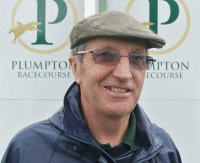
As racecourses go, Plumpton is pretty small, one of the smallest in the UK in fact. Its compact nine-furlong course stages sixteen National Hunt meetings a year between September and May and, come rain or shine, it draws as many as 6,000 on main race days. Its uncomplicated circuit, with just two bends and two straights, means you can see the whole of a race from whatever vantage point you choose, and runners will pass you at least twice. Delightfully set in the lea of the South Downs, it is very racegoer friendly. Unsurprisingly, readers of Racing Post recently voted it the country's best viewing course.
Plumpton is making a habit of getting accolades. As reported in the last issue of Pitchcare, the course topped its earlier Racecourse Groundstaff of the Year award in the jump course category - repeating its 2009 win - by being named the best overall racecourse at the Racecourse Association's Showcase Awards evening at Haydock Park in November.
The man very much behind this is Mark Cornford, Plumpton's Head Groundsman and, since 2004, Clerk of the Course too.
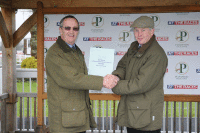
It was an extraordinary achievement given the resources at his disposal compared to big league courses. Mark is very proud of what the owners, trainers, and jockeys have obviously felt about their efforts. What is the course and the man who looks after it like?
The first big meeting of the year, the Sussex National, had been successfully staged the previous Sunday, but it was just days before the next meeting, one of three billed in January. It's the wettest day of the winter so far. Twenty-nine millimeters of rain had fallen on the course in a couple of hours. We chatted undercover overlooking the finishing post.
"If I was doing my 'stick and feet' duty now, it would quickly become an inspection, with the ground waterlogged and unraceable; going reports reflect the conditions you have, with one eye on the forecast, to relay to connections the possibility of any further changes."
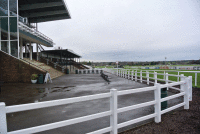
Thankfully, postponements are rare at Plumpton these days! Every race day, whilst still doing his very early morning course walk, Mark makes his phone call to the RCA going line with his assessment of conditions, so that Talk Sport and other on-air media can broadcast the information before 7.00am.
"In the old days, you used to have to call upon the Chairman of Stewards for on the day decisions about whether to race or not. The rules changed and, these days, the buck stops firmly with the Clerk of the Course, though you can still call in a steward for advice if there is serious doubt either way."
"I can't deny that, some days, it is a responsibility that weighs heavily. It affects many people who depend on a day's racing, and I don't always sleep easy the night before a meeting. Nevertheless, I love every minute of it."
Frost is a real villain of the piece for any racecourse, and Plumpton, being so open, is at risk. Mark says reliable indications were that there would be no frost for the big Sussex National meeting on 4th January, so he made the decision not to order the black polypropylene covering widely used at courses to offer protection down to minus 4OC. It's a decision not made lightly either way. At Plumpton, it cost the best part of £20,000 to install, taking the supplying contractor over four hours to cover the entire circuit. On the other hand, a frost postponement is a big dent in the course's income. The contractor needs at least forty-eight hours notice to provide installation, and Mark's anxiety grew as, just hours before his going report, temperatures began to drop, contrary to forecasts. It didn't quite get down to freezing though, and nearly 2,500 punters had a great day's racing.
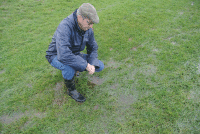
"Every single meeting is important to us at Plumpton, for our survival, so we try our damnedest. We're never stupid, and would never take risks. The safety of horses and jockeys always comes first, but I know the 'jocks' appreciate that we will move heaven and earth to keep a meeting on. In last winter's exceptional wet we did lose two race days, yet many said a personal thanks for making racing possible! I have a great relationship with them."
There's been a Cornford family connection at Plumpton for sixty years or more. Mark himself first joined the ground staff in1980, but he recalls his father working as a race day employee on the jumps and hurdles near the top end of the course close to the stables.
"As a boy back in the sixties, I used to sit on a pile of hay bales by the course crossing watching the horses go by; dad used to let me stand on the track for the last race when he would hold my arm and say watch 'em jump this son. He was nicknamed Corny as, strangely, were the jumps in his care. One or two locals call me Corny too."

He went into engineering when he left school but, when a full-time position on the ground staff became available in May 1980, he grabbed it. He did some formal training in the early days, but has pretty much learned everything there is to know about racecourse upkeep by doing the jobs, and makes a point of saying that he still enjoys doing the 'dirty work' essentials. There can't be many other Clerks of the Course that can say that.
Mark had worked for a number of his Clerk predecessors before taking up duties himself. In the old days, he says the grounds team had a manager and, together, they were the only ever-present staff on the course. The Clerk, who was very much their boss, had an office away from the course. In Plumpton's case it was at Haywards Heath and, for a time, Fontwell Park, when it was under the same ownership. There wasn't the close relationship between Clerk and groundstaff, as there is now at Plumpton or, for that matter, at most courses these days.
In the past, a military culture and etiquette was the way, recalls Mark, but that's all but disappeared. "Often as not stewards were Majors, Captains or Brigadiers. It made for excellent discipline, and this is a legacy that racing can be very proud of."
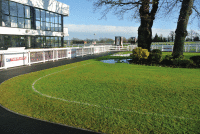
There is one area that he has yet to study and pass to achieve full Clerk of the Course status, and that involves race planning, which means having a controlling say in what races are staged at the course and the conditions surrounding them. This currently falls to the CEO, but Mark plans to train for this soon and take up these duties too. He is anticipating this latest challenge with relish.
Initially, he was head groundsman and Clerk of the Course on race day only, but gradually things have evolved and his Clerk duties have grown, though not in any way at the expense of his groundsmanship. The award at Haydock bears this out.

In the past, Clerks had to be licensed. That is no longer the case. The BHA simply recognises hard earned qualifications in either or both of two categories. Mark has one under his belt: the other is a matter of time.
Course work is very much in the hands of Mark and his grounds team. Currently there are three full-time staff and two part-time, each with two regular days work a week.
Outside help is clear cut and only for essential large-scale maintenance, either routine or annual. After each meeting, whole course divoting has, for the past three years, been conducted by specialists Sterling Services. Prior to that, Mark gathered an additional team of locals to do this repair work, but numbers available for this were dwindling and he had to be sure of getting a reliable extra workforce. Walking and forking is the technical term for the work and Mark assesses how big a team he needs once hoof damage has been properly surveyed.
"You pay by the hour and by the man," said Mark. "After the Sussex National meeting, surface disruption wasn't too bad, so we shaved the number down to eight from Sterling. It can be twelve or more when the disruption is considerable. The sooner you can get this job done, the better."
Upside-down chain harrowing, behind two quad bikes, is sometimes adopted at Plumpton to help with divoting and, if conditions are right, Mark says it's a definite aid to post-racing repair, minimising the manual work needed.

The non-racing period between May and September is summer maintenance time and Mark's rule is there are always two from the team on duty every day.
One of the early summer tasks is to clear as much of the plastic railing out of the way to ease mowing. Cutting is done using a 4-metre Votex front-mounted topper and the whole course can be trimmed comfortably in a day. National Hunt courses are permitted to cut between 4-6 inches, but Mark opts for the lower level and never cuts the day before a meeting because he likes a bit of fresh growth. The mowing season varies year to year but, as a rule, very little course topping takes place between November to February.
Twice a year, Mark gets nearby contractor Peter J Mannington to verti-drain the course, which is then topdressed with sand. This summer, more drainage work on the bottom bend is planned and contractors, Speedcut, are returning to install sand banding to supplement the pipework it put in previously. These 2-inch trenches, 10-inches deep, will then be half filled with shingle and topped with sand.
It is the obstacles that make National Hunt racing what it is, so I asked Mark about how they look after them at Plumpton.
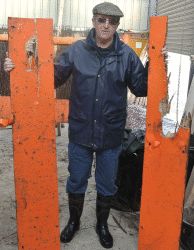
The course has five flights of hurdles, each flight comprising five hurdle sections. The cost, brand new, of a hurdle would be around £200, so a whole flight is about £1,000. At Plumpton, Mark and his team conduct build and repair themselves by buying in necessary components - timber, birch and padding. Each hurdle top to bottom rail is 3 feet 6 inches but, in position at an angle, they are 37 inches off the ground.
"Depending on field sizes and going, I'd expect to have to repair between eight and fifteen hurdles after each meeting," says Mark. "The horses sometimes knock them to pieces. It's practically a full-time job, a bit of a treadmill if you like, but without decent obstacles there would be no jump racing. It's what makes our world go round."
The five plain fences and one open ditch each have six sections which can be unbolted and moved if necessary, though they haven't had to do this for some years now. Post event maintenance is, by and large, replacement in-situ of damaged birch.
Whole fences are taken off the course at the end of the season for annual makeover. Three are completely rebuilt and three refurbished. The next year this is reversed, and so the cycle continues. The take-off and landing areas around each fence are periodically levelled, as necessary.
The Inspector of Racecourses - and Peter Hobbs is the local one for Plumpton - will pay periodic visits to see that the hurdles and fences meet the high standards required by the BHA.
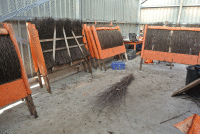
So, what's special about Plumpton? Quite simply, people love coming here. It's very welcoming and, as Mark emphasises, officialdom is kept to a minimum. "We like to think we are highly professional, yet give a family feeling to the place," he says.
Last July, the Racecourse Association announced that Plumpton had been judged one of the top ten visitor attraction racecourses in England and Wales, according to an independent assessment by Visit England. Criteria included efficiency and friendliness of customer service and the availability and cleanliness of facilities for both racegoers and owners and trainers. The top ten were Ascot, Doncaster, Epsom Downs, Exeter, Newmarket, Wincanton, Royal Windsor and York, with Plumpton and Salisbury newcomers to this select group.
"Having been a 'hidden gem' of English racing for a while, it's very nice to receive wider public recognition," says Plumpton CEO Michael Moloney on the course's website.
Even on this wettest of mid-winter non-race days, you can see why it's a top-tenner.
